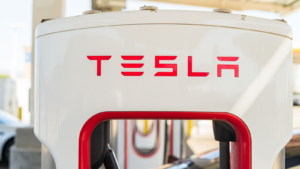That’s a question on the minds of many investors. Technological breakthroughs in areas like artificial intelligence and electric vehicles point to several companies “joining the club.”
So, too, do breakthroughs/long-term trends in other areas, like healthcare and financial services. There are also mega-cap companies that, while growing at only a moderate pace, are within reach of hitting the trillion-dollar mark within this decade.
With this in mind, let’s take a look at seven companies that appear most likely to become trillion-dollar stocks and when exactly each of them can reach this milestone.
Advanced Micro Devices (AMD)

When it comes to the next chip stock to join Nvidia (NASDAQ:NVDA) in the trillion dollar club, Advanced Micro Devices (NASDAQ:AMD) is a name that to many may first come to mind. Yet, while the chip designer is currently making its own big moves in AI chips, reaching a $1 trillion market cap may be easier said than done.
AMD stock currently has a market cap of around $236 billion. Hence, shares need to surge more than fourfold to join the trillion-dollar club. With AMD rising eightfold over the past five years, quadrupling in price should be a cinch, right?
Not necessarily. Due to this year’s ‘AI mania,’ AMD’s AI catalyst appears to be priced in and then some. Unless the company’s AI endeavors result in earnings many times that of current estimates, even reaching trillion-dollar status by 2030 may be, at best, a stretch.
Broadcom (AVGO)

AMD may not be on the fast track to becoming one of the next trillion-dollar companies, but another semiconductor firm might be. It is Broadcom (NASDAQ:AVGO). Why? AVGO is already more than halfway there, with a market cap of $527.2 billion.
Furthermore, as argued previously, AVGO stock may have a far greater runway than other top AI stocks. Valuation is a big reason for this. AVGO trades at a forward multiple in the low 20s. “Magnificent Seven” AI stocks trade for 30-40 times forward earnings.
Also, Broadcom could eke out billions in cost/growth synergies from its recent VMware merger, enabling the company to beat current earnings growth expectations. To reach a $1 trillion market cap, all AVGO needs to do is rise in value by just under 90%. A mix of multiple expansion and earnings growth could get it there sooner than you think.
Berkshire Hathaway (BRK-A, BRK-B)
Berkshire Hathaway (NYSE:BRK-A, NYSE:BRK-B), legendary investor Warren Buffett’s investment vehicle, is even closer than AVGO to reaching the trillion-dollar threshold. The Omaha, Nebraska-based conglomerate currently has a market cap of $777.9 billion.
This means all BRK.A/BRK.B stock needs to do is rise by 28.5% to achieve this valuation goal. Given the mostly “old economy” nature of Berkshire and its various businesses/holdings, not to mention its huge size, you may think that reaching a trillion is, at best, several years away for the company.
However, as a Seeking Alpha commentator recently argued, the “road to $1 trillion” may not be as long as it seems. Per the commentator, even if growth among Berkshire’s businesses screeched to a halt, adding these stagnant cash flows to the company’s war chest would still justify a move to a $1 trillion valuation.
Eli Lilly (LLY)

Admittedly, Eli Lilly (NYSE:LLY) may be the most questionable candidate to become one of the next trillion-dollar companies. Shares in the big pharma firm have surged to a valuation of $522.4 billion thanks to the massive potential of its drug candidate, Zepbound.
While initially developed as a treatment for diabetes under the Mounjaro name, Eli Lilly has been working to get Zepbound approved as an obesity treatment. Given Novo Nordisk’s (NYSE:NVO) success with its Ozempic/Wegovy obesity treatment, it’s no surprise that Wall Street is very bullish on LLY stock.
Yet while further positive news regarding Mounjaro/Zepbound may lead to further gains for LLY, with shares trading for 88.4 times earnings, one can argue that the future growth potential of this and other obesity treatments is already priced into the stock. Hence, you may want to tread carefully with this trillion-dollar contender.
Meta Platforms (META)

With a market cap of $919.7 billion, it may be a matter of months, not years, before Meta Platforms (NASDAQ:META) becomes one of the next trillion-dollar stocks. In fact, as I argued recently, shares in the Facebook and Instagram parent could climb to a value well above $1 trillion during 2024.
Put simply, a combination of earnings growth, further progress with the company’s AI efforts, plus greater appreciation of Meta’s AI bona fides could result in META stock (at around $360 per share today) rallying to $500 or $600 per share.
In other words, it’s within the realm of possibility that Meta Platforms will become a $1.5 trillion (by market cap) company within a year. That’s a valuation that would put Meta’s valuation in the same ballpark as other trillion-dollar club members like Alphabet (NASDAQ:GOOG, NASDAQ:GOOGL) and Amazon (NASDAQ:AMZN).
Tesla (TSLA)

It may be strange to say that Tesla (NASDAQ:TSLA) is one of the next trillion-dollar companies. Mainly because the EV industry leader was, at one point, a trillion-dollar company. In October 2021, just before the 2021-2022 stock market downturn, TSLA attained a market cap exceeding $1 trillion.
The stock experienced a massive drawdown from late 2021 through January 2023. Following this, a massive rebound throughout 2023. As a result, TSLA stock is back to a market cap of around $804.8 billion. All that’s necessary to send Tesla back to trillion-dollar status is a 24.25% move higher.
Even as Tesla skeptics point to issues like the EV sales slowdown as signs that TSLA will slide lower in 2024, as I pointed out last week, a potential catalyst could supercharge shares later in the year: the debut of a low-priced, mass-market Tesla EV model.
Visa (V)

Visa (NYSE:V) is another mega-cap that’s halfway towards the trillion-dollar market cap mark. Shares in payment technology companies have produced outsized long-term returns for investors since the stock’s debut in the late 2000s.
Following an incredible run from a split-adjusted $15-$20 per share in early 2008 to around $260 per share today, some may expect V stock to produce more modest returns from here. However, the move from cash-based to card/digital-based transactions continues. This company also continues to benefit from having a deep economic moat. It is not far-fetched to think that Visa could continue reporting double-digit annual earnings growth in the years to come.
In short, Visa is one of the “it’s a matter of when, not if” trillion-dollar contenders. With this, plus the stock’s reasonable valuation (26.3 times earnings) compared to growth forecasts, consider making it a long-term buy.
On the date of publication, Thomas Niel did not hold (either directly or indirectly) any positions in the securities mentioned in this article. The opinions expressed in this article are those of the writer, subject to the InvestorPlace.com Publishing Guidelines.

